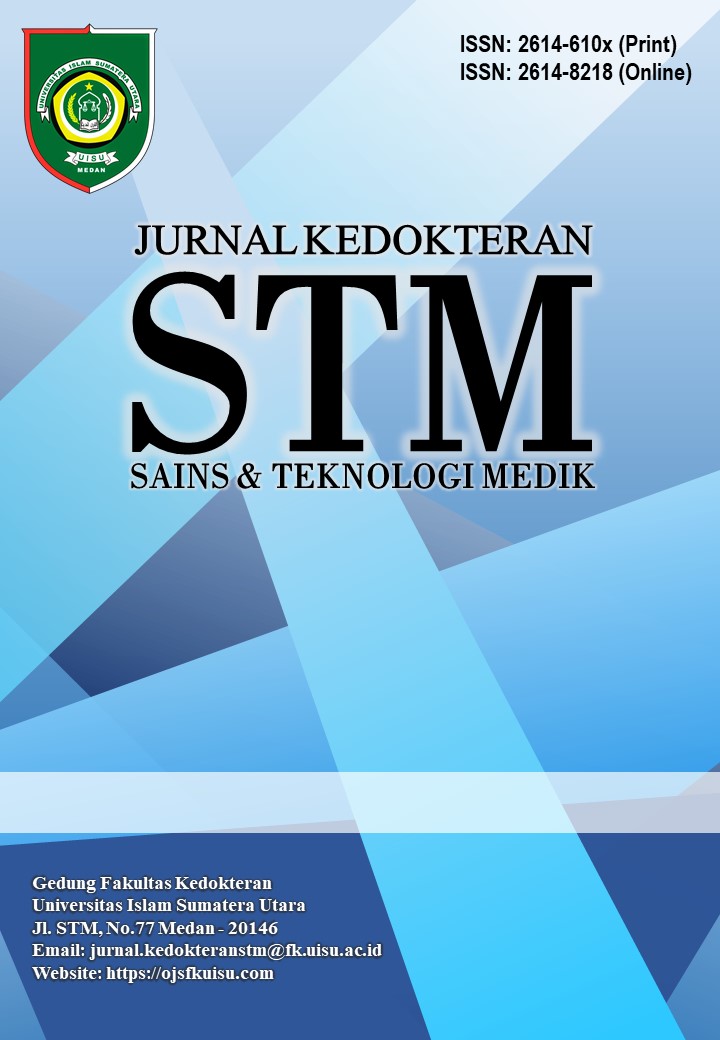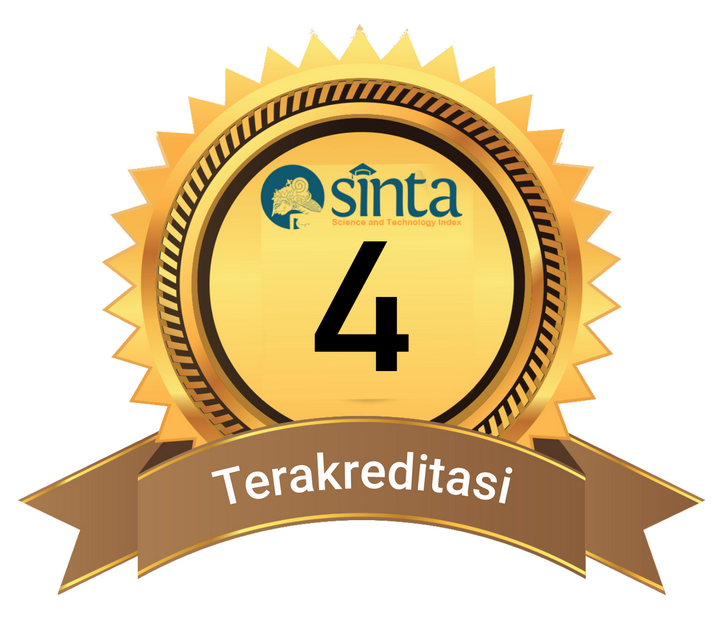HIPOXIA-INDUCIBLE FACTOR 1 (HIF-1) DAN ANGIOGENESIS TUMOR: MEKANISME, IMPLIKASI KLINIS, DAN POTENSI TERAPI
HIPOXIA-INDUCIBLE FACTOR 1 (HIF-1) AND TUMOR ANGIOGENESIS: MECHANISMS, CLINICAL IMPLICATIONS, AND THERAPEUTIC POTENTIAL
Abstract
Hypoxia plays a crucial role in tumor development and progression by inducing angiogenesis. One of the key mediators in the hypoxic response is Hypoxia-Inducible Factor-1 (HIF-1), which regulates the expression of pro-angiogenic genes such as vascular endothelial growth factor (VEGF). HIF-1 activation, whether through hypoxic conditions or genetic mutations, contributes to the formation of new blood vessels that support tumor growth and metastasis. This article is a narrative review aimed at summarizing the molecular mechanisms of HIF-1 in tumor angiogenesis and exploring its potential as a target for cancer therapy. The discussion includes HIF-1 regulation under normoxic and hypoxic conditions, its impact on the structure of tumor vasculature, and the development of therapies targeting the HIF-1 pathway, such as HIF-1α inhibitors, dimerization blockers, and degradation-inducing agents. By understanding the central role of HIF-1 in angiogenesis and tumor progression, this article aims to contribute a scientific foundation for the development of anti-angiogenic therapies and future research in the field of molecular oncology.
Abstrak
Hipoksia merupakan kondisi yang berperan penting dalam perkembangan dan progresi tumor melalui induksi angiogenesis. Salah satu mediator utama dalam respons hipoksia adalah Hypoxia-Inducible Factor-1 (HIF-1), yang berperan sebagai regulator utama homeostasis oksigen. HIF-1 mengatur ekspresi berbagai gen yang terlibat dalam angiogenesis, termasuk vascular endothelial growth factor (VEGF), angiopoietin, dan faktor pertumbuhan lainnya. Dalam kondisi hipoksia, HIF-1α tidak mengalami degradasi, sehingga terjadi peningkatan ekspresi VEGF yang memicu pembentukan pembuluh darah baru guna memenuhi kebutuhan oksigen sel tumor. Selain itu, mutasi pada onkogen dan tumor suppressor genes dapat menyebabkan aktivasi HIF-1 yang tidak tergantung pada hipoksia, sehingga semakin meningkatkan angiogenesis tumor. Pemahaman lebih lanjut tentang peran HIF-1 dalam angiogenesis telah membuka peluang untuk pengembangan terapi target kanker yang menghambat jalur HIF-1. Terapi ini mencakup inhibisi ekspresi HIF-1α, pencegahan dimerisasi dengan HIF-1β, serta penghambatan interaksi dengan DNA. Dengan demikian, modulasi jalur HIF-1 dapat menjadi pendekatan yang menjanjikan dalam terapi kanker berbasis anti-angiogenesis.
References
Kretschmer M, Rüdiger D, Zahler S. Mechanical aspects of angiogenesis. Cancers (Basel). 2021;13(19):4987.
Basheeruddin M, Qausain S. Hypoxia-Inducible Factor 1-Alpha (HIF-1α): An Essential Regulator in Cellular Metabolic Control. Cureus. 2024;16(7).
Goswami AG, Basu S, Huda F, et al. An appraisal of vascular endothelial growth factor (VEGF): the dynamic molecule of wound healing and its current clinical applications. Growth Factors. 2022;40(3–4):73–88.
Dudley AC, Griffioen AW. Pathological angiogenesis: mechanisms and therapeutic strategies. Angiogenesis. 2023;26(3):313–347.
Liu Z-L, Chen H-H, Zheng L-L, Sun L-P, Shi L. Angiogenic signaling pathways and anti-angiogenic therapy for cancer. Signal Transduct Target Ther. 2023;8(1):198.
Haibe Y, Kreidieh M, El Hajj H, et al. Resistance mechanisms to anti-angiogenic therapies in cancer. Front Oncol. 2020;10:221.
Ansari MJ, Bokov D, Markov A, et al. Cancer combination therapies by angiogenesis inhibitors; a comprehensive review. Cell Commun Signal. 2022;20(1):49.
Ribatti D, Pezzella F. Overview on the different patterns of tumor vascularization. Cells. 2021;10(3):639.
Della Rocca Y, Fonticoli L, Rajan TS, et al. Hypoxia: molecular pathophysiological mechanisms in human diseases. J Physiol Biochem. 2022;78(4):739–752.
Elebiyo TC, Rotimi D, Evbuomwan IO, et al. Reassessing vascular endothelial growth factor (VEGF) in anti-angiogenic cancer therapy. Cancer Treat Res Commun. 2022;32:100620.
Lugano R, Ramachandran M, Dimberg A. Tumor angiogenesis: causes, consequences, challenges and opportunities. Cell Mol Life Sci. 2020;77:1745–1770.
Eelen G, Treps L, Li X, Carmeliet P. Basic and therapeutic aspects of angiogenesis updated. Circ Res. 2020;127(2):310–329.
Wu J, Liu Y, Fu Q, Cao Z, Ma X, Li X. Characterization of tumor-associated endothelial cells and the development of a prognostic model in pancreatic ductal adenocarcinoma. Biochim Biophys Acta (BBA)-General Subj. 2024;1868(3):130545.
Wu Q, You L, Nepovimova E, et al. Hypoxia-inducible factors: master regulators of hypoxic tumor immune escape. J Hematol Oncol. 2022;15(1):77.
Sasidharan R, Schippers JHM, Schmidt RR. Redox and low-oxygen stress: signal integration and interplay. Plant Physiol. 2021;186(1):66–78.
Alique M, Sánchez-López E, Bodega G, Giannarelli C, Carracedo J, Ramírez R. Hypoxia-inducible factor-1α: the master regulator of endothelial cell senescence in vascular aging. Cells. 2020;9(1):195.
Zimna A, Kurpisz M. Hypoxia-Inducible Factor-1 in Physiological and Pathophysiological Angiogenesis: Applications and Therapies. Biomed Res Int. 2015;2015:1–13.
Fultang N, Li X, Li T, Chen YH. Myeloid-derived suppressor cell differentiation in cancer: Transcriptional regulators and enhanceosome-mediated mechanisms. Front Immunol. 2021;11:619253.
Belisario DC, Kopecka J, Pasino M, et al. Hypoxia dictates metabolic rewiring of tumors: implications for chemoresistance. Cells. 2020;9(12):2598.
Zhang Y, Wang J, Li Z. Association of HIF1-Α gene polymorphisms with advanced non-small cell lung cancer prognosis in patients receiving radiation therapy. Aging (Albany NY). 2021;13(5):6849.
Doktorova H, Hrabeta J, Khalil MA, Eckschlager T. Hypoxia-induced chemoresistance in cancer cells: The role of not only HIF-1. Biomed Pap Med Fac Palacky Univ Olomouc. 2015;159(2).
Pircher T, Wackerhage H, Aszodi A, Kammerlander C, Böcker W, Saller MM. Hypoxic signaling in skeletal muscle maintenance and regeneration: a systematic review. Front Physiol. 2021;12:684899.
Dzhalilova DS, Makarova O V. HIF-dependent mechanisms of relationship between hypoxia tolerance and tumor development. Biochem. 2021;86:1163–1180.
Le Joncour V, Guichet P-O, Dembélé K-P, et al. Targeting the urotensin II/UT G protein-coupled receptor to counteract angiogenesis and mesenchymal hypoxia/necrosis in glioblastoma. Front Cell Dev Biol. 2021;9:652544.
Daks AA, Fedorova OA, Shuvalov OY, Parfenev SE, Barlev NA. The role of ERBB2/HER2 tyrosine kinase receptor in the regulation of cell death. Biochem. 2020;85:1277–1287.
Kour A, Sambyal V, Guleria K, et al. In silico pathway analysis based on chromosomal instability in breast cancer patients. BMC Med Genomics. 2020;13:1–13.
Hoefflin R, Harlander S, Schäfer S, et al. HIF-1α and HIF-2α differently regulate tumour development and inflammation of clear cell renal cell carcinoma in mice. Nat Commun. 2020;11(1):4111.
Wang X, Du Z, Xu T, et al. HIF-1α is a rational target for future ovarian cancer therapies. Front Oncol. 2021;11:785111.
Gupta J, Tayyib NA, Jalil AT, et al. Angiogenesis and prostate cancer: MicroRNAs comes into view. Pathol Pract. 2023;248:154591.
Liu Q, Guan C, Liu C, Li H, Wu J, Sun C. Targeting hypoxia-inducible factor-1alpha: A new strategy for triple-negative breast cancer therapy. Biomed Pharmacother. 2022;156:113861.
Youssef ME, Cavalu S, Hasan AM, Yahya G, Abd-Eldayem MA, Saber S. Role of ganetespib, an HSP90 inhibitor, in cancer therapy: from molecular mechanisms to clinical practice. Int J Mol Sci. 2023;24(5):5014.
Joshi H, Tuli HS, Ranjan A, et al. The Pharmacological Implications of Flavopiridol: An Updated Overview. Molecules. 2023;28(22):7530.
Copyright (c) 2025 Ira Cinta Lestari, Ramadhan Bestari, Dewi Pangestuti, Suryani Eka Mustika

This work is licensed under a Creative Commons Attribution-ShareAlike 4.0 International License.



